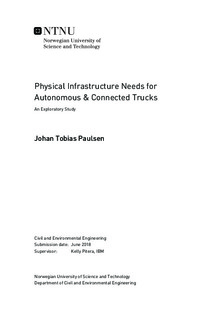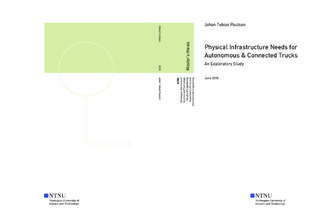| dc.description.abstract | The rapid development of autonomous vehicles has spawned autonomous trucks and concepts such as truck platoons. These technologies can potentially contribute to lower several key issues regarding road transportation, like number of fatalities, energy consumption and traffic flow. Between 2016 and 2050, transportation of goods on roads in Norway are expected to increase by nearly 100 %, and with the country s spread population, coastline and mountains, very few roads are high-quality 4-lane highways, where these concepts have had a few limited real-life tests. Together with scarce literature on infrastructure impacts, it is difficult to state how autonomous trucks and truck platoons will function in Norway and what potentially must be done to make roads supportive.
With the overall goal of examining how road design will be affected by the use of autonomous trucks in 2050, this thesis explores the future of truck automation through the following research questions:
1. What is the differences in vehicle characteristics for conventional trucks vs autonomous trucks?
2. What elements of road design are impacted by autonomous trucks and/or truck platoons?
3. How can these elements be improved to be supportive of autonomous trucks and truck platoons?
This exploratory study takes use of existing literature, experts and Norwegian road design handbooks through the qualitative methods of literature review, interview and document analysis. As the necessary technologies and concepts are relative new, the amount of literature is low, with quantitative data even more scarce. The procedure took use of the existing literature to gain knowledge and understanding to create a basis for analysis and discussions regarding the future physical infrastructure, with the findings pointing towards what areas that are likely to be impacted and in need of further research.
The results found first-generation autonomous trucks to only remove the risk-taker (the driver), creating a different driving behavior. Later generations will improve on other vehicles characteristics, including the reaction time. These changes decrease the minimum requirements of most design parameters, with stopping sight distance and vertical curvature seeing the biggest improvements (75 and 51 %). It is however, the driving behavior that creates the biggest possibilities for road design, as it creates a flexibility that has not been seen in road design before. Guidelines to lead human drivers or to keep them alert, are no longer needed, and therefore can factors such as travel time, environmental or economics be decisive.
Several road elements are likely to be impacted of truck platoons, due to their long length, different load dynamics and higher weight. Bridges might require reinforcements, the same
VI
goes for railings. Other structural elements, including pavements, are likely to see changes as well, but there has not been enough research conducted for any of these elements. Overtaking lanes are also influenced by truck platoons, as the overtaking distances of a two-truck platoon increases by 160 % compared to a 22-meter long reference truck, in a worst-case scenario. Tunnels and junctions are likely to see benefits of the digital infrastructure and its corresponding connective technologies, with only minimal adjustments to the physical infrastructure. Precision driving will allow lanes to be narrower than ever before, either reducing the cross-sectional space needed for a road, or in the case of a 4-lane highway, creates enough space for a fifth lane. | |

